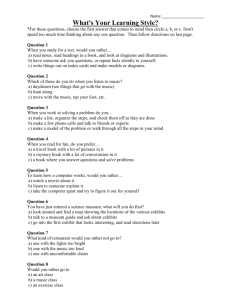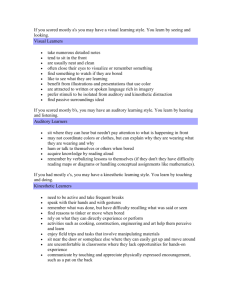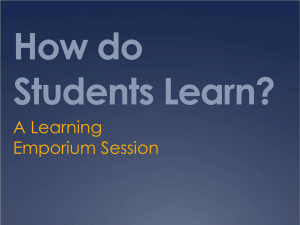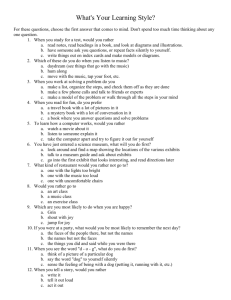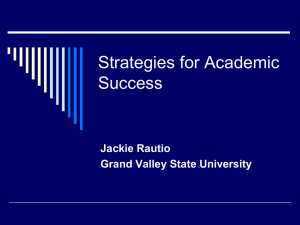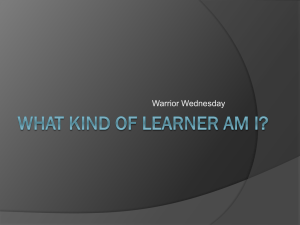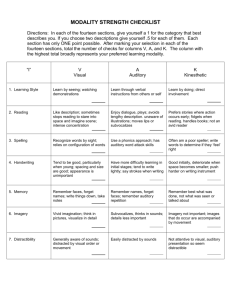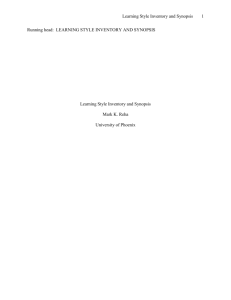Learning Styles Inventory Scoring Guide
advertisement
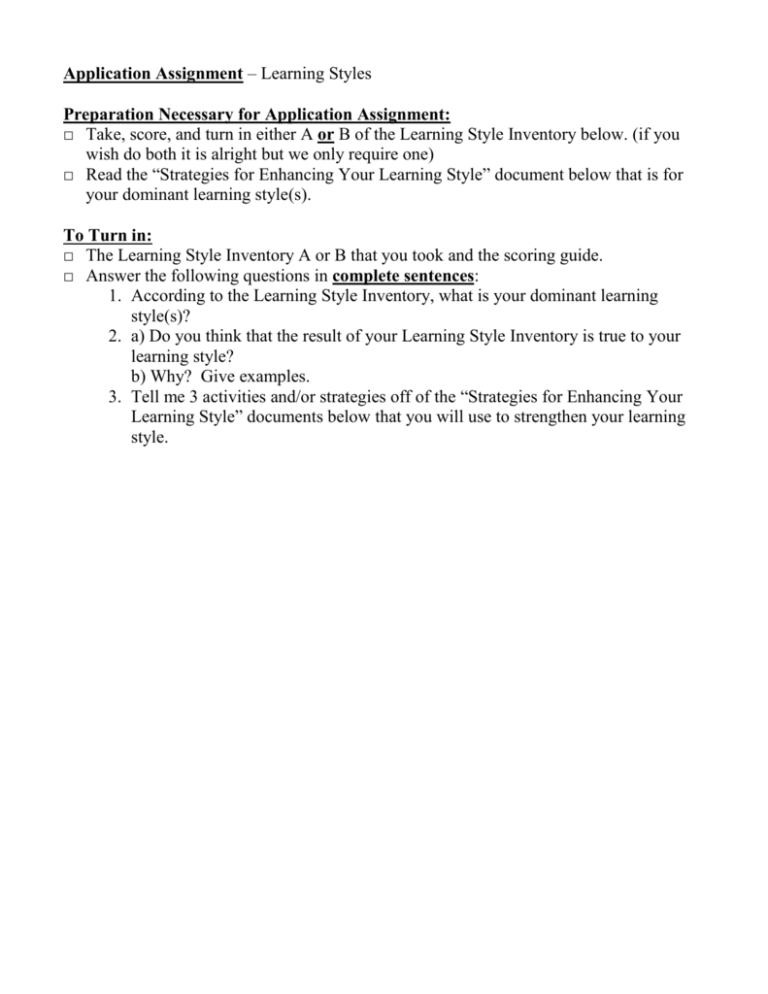
Application Assignment – Learning Styles Preparation Necessary for Application Assignment: □ Take, score, and turn in either A or B of the Learning Style Inventory below. (if you wish do both it is alright but we only require one) □ Read the “Strategies for Enhancing Your Learning Style” document below that is for your dominant learning style(s). To Turn in: □ The Learning Style Inventory A or B that you took and the scoring guide. □ Answer the following questions in complete sentences: 1. According to the Learning Style Inventory, what is your dominant learning style(s)? 2. a) Do you think that the result of your Learning Style Inventory is true to your learning style? b) Why? Give examples. 3. Tell me 3 activities and/or strategies off of the “Strategies for Enhancing Your Learning Style” documents below that you will use to strengthen your learning style. Learning Styles Preference Inventory A (General) Read each statement and select the appropriate response number as it applies to you. Often – 3 Sometimes- 2 Seldom/Never- 1 _____1) I remember information better if I write it down. _____2) My papers and notebooks always seem messy. _____3) I start a project before reading the directions. _____4) Looking at the person helps keep me focused. _____5) When I read, I need to use my index finger to track my place on the line. _____6) I hate to sit at a desk for long periods of time. _____7) I need a quiet place to get my work done. _____8) I do not follow written directions well. _____9) I prefer first to see something done and then to do it myself. _____10) When I take a test, I can see the textbook page in my head. _____11) If I hear something, I will remember it. _____12) I use the trial and error approach to problem-solving. _____13) I need to write down directions, not just take them verbally. _____14) Writing has always been difficult for me. _____15) I like to read my textbook while riding an exercise bike. _____16) Music or background noise distracts my attention from the task at hand. _____17) I often misread words from the text, i.e. “them” for “then”). _____18) I take frequent study breaks. _____19) I don’t always get the meaning of a joke. _____20) I would rather listen and learn than read and learn. _____21) I have a difficult time giving step-by-step instructions. _____22) I doodle and draw pictures on the margins of my notebook pages. _____23) I’m not very good at interpreting an individual’s body language. _____24) I enjoy sports and do well at several different types of sports. _____25) I have trouble following lectures. _____26) Pages with small print or poor quality copies are difficult for me to read. _____27) I use my hands when describing things. _____28) I react very strongly to colors. _____29) My eyes tire quickly, even though my vision check-up is always fine. _____30) I have to rewrite or type my class notes to reinforce the material. Learning Styles Preference Inventory B (Math Specific) Read each statement and select the appropriate response number as it applies to you. Often – 3 Sometimes- 2 Seldom/Never- 1 _____1) I remember math better if I write it down. _____2) I learn best from a lecture and worst from the whiteboard or textbook. _____3) I learn best in math when I just get in and do something with my hands. _____4) I prefer to study math in a quiet place. _____5) I hate taking notes; I prefer just to listen to lectures. _____6) I learn and study math better when I can pace the floor, shift positions, tap my pencil etc. _____7) It’s hard for me to understand math when someone explains it without writing it down. _____8) I have difficulty following written solutions on the board unless the teacher verbally explains all the steps. _____9) I learn math best when I can manipulate or use hands-on examples. _____10) It helps when I can picture working a problem out in my mind. _____11) I can remember more of what is said to me than what I see. _____12) I usually can’t verbally explain how I solved a math problem. _____13) I enjoy writing down as much as I can in math. _____14) The more people explain math to me, the faster I learn it. _____15) I can’t just be shown how to do a problem; I must do it myself so I can learn. _____16) I need to write down all the solutions and formulas in order to remember them. _____17) I don’t like reading explanations in my math book; I’d rather have someone explain the new material to me. _____18) I’ve always liked using my fingers to figure out math. _____19) When taking a math test, I can often see in my mind the page in my notes or in the text where the explanations or answers are located. _____20) I tire easily when reading math, though my eyes are okay. _____21) I need to take lots of breaks and move around when I study math. _____22) I get easily distracted or have difficulty understanding in math class when there is talking or noise. _____23) I wish my math teachers would lecture more and write less on the board. _____24) I prefer to use my intuition to solve math problems, to feel or sense what’s right. _____25) Looking at my math teacher when he or she is lecturing helps me to stay focused. _____26) I repeat the numbers to myself when mentally working out math problems. _____27) I enjoy figuring out math games and math puzzles when I learn math. _____28) If I’m asked to do a math problem, I have to see it in my mind’s eye to understand what is being asked of me. _____29) I can work a math problem out more easily if I talk myself through the problem as I solve it. _____30) I learn math best if I can practice it in real-life experiences. This survey is adapted from Conquering Math Anxiety, by Dr. Cynthia A. Arem. Learning Styles Inventory Scoring Guide Write your score for each statement beside the appropriate number below, then add all the scores in each column. 1)____ 2)____ 3)____ 4)____ 5)____ 6)____ 7)____ 8)____ 9)____ 10)____ 11)____ 12)____ 13)____ 14)____ 15)____ 16)____ 17)____ 18)____ 19)____ 20)____ 21)____ 22)____ 23)____ 24)____ 25)____ 26____ 27)____ 28)____ 29)____ 30)____ Visual Auditory Kinesthetic Total: The largest number in the total of the three columns above indicates your dominant learning style. Visual learners learn best by seeing. Visual learners benefit from reading the book, seeing videos, charts, graphs, diagrams and color. Auditory learners learn best by listening. Auditory learners benefit from lectures, listening to recordings and talking to themselves. Kinesthetic (or tactile) learners learn best by moving, touching or doing. Kinesthetic learners benefit from hands-on experiments, taking notes, writing and re-writing notes. Strategies for Enhancing Your Learning Style Visual Always take notes during class or when working with a study partner(s) or tutors Ask for or otherwise obtain written instructions Make drawings, sketches, diagrams, or tables/charts when figuring out application problems Highlight key points and use color coding systems when possible in your book, notes and handouts Use a flashcard system (make your own with index cards) to review important concepts, formulas, definitions, examples, etc. During class, keep eyes focused on the instructor and what they are writing down. Try to write down what instructor writes on the board and put question marks next to things you do not understand (so that you may follow up for help later) Use a second math book or more to read how different books explain the same topic Read the section(s) that are to be covered in the book prior to class lecture on the sections Read and review previous class notes before the next class Make use of student study guides, supplemental course CD’s, videos and handouts Create concept maps of covered information Sit in the front of the classroom to avoid other visual distractions and to better focus on the instructor Strategies for Enhancing Your Learning Style Auditory Record lectures, if possible, then listen to recordings while you are engaged in other activity (working out, driving, studying) Participate in class discussion (you can do this by quietly saying the answer to yourself if you are not comfortable raising your hand) Listen carefully during lecture for understanding and write down notes immediately after class (work with a classmate that is a visual learner to check your notes) Ask your teacher to repeat important concepts or clarification if needed Ask lots of questions during class, after class, and during study sessions Restate, in your own words, concepts that you are trying to learn Recite formulas or definitions out loud when studying Talk about math problems with your study partner or anyone who will listen (spouse, friend, dog...) Read class notes out loud After reading your book, describe what you read out loud Record your explanations or recitations of formulas/definitions and play back your recordings Compose songs to use to remember formulas and definitions Strategies for Enhancing Your Learning Style Kinesthetic (Tactile) Work out as many problems as you can. The key is to do a LOT of repetition! If possible, use a physical model of the concept you are trying to learn (use measuring devices, coins, other objects) When working with study partner or tutor, work out problems with them or work another similar problem after they work out one Determine motions that help focus your mind (tapping your foot, chewing gum, working a handheld stress ball or Koosh ball) Review math concepts while you are engaged in other activities (working out, driving, etc.) Use your hands or other objects to figure out problems Use a calculator Rewrite class notes Take frequent breaks to move around or shift while studying

